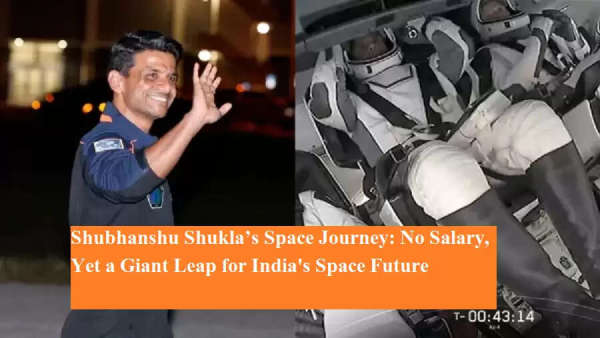
Shubhanshu Shukla Makes History as Second Indian to Reach Space—Here’s Why He Won’t Be Paid for It
Indian astronaut Shubhanshu Shukla is set to etch his name in history by becoming only the second Indian to reach the International Space Station (ISS). His mission marks a major milestone in India's space journey. However, in a surprising revelation, it has been confirmed that Shukla will not receive any salary for his 14-day stay in orbit.
This mission, dubbed Axiom-4 (Ax-4), is a result of a strategic collaboration between ISRO (Indian Space Research Organisation) and NASA (National Aeronautics and Space Administration). While it is a joint international effort, the entire cost associated with Shukla’s participation has been borne by India.
According to multiple reports, the Government of India has invested an estimated ₹548 crore in the Axiom-4 mission. This significant funding covers training, launch logistics, travel arrangements, and the research activities that Shukla will undertake in space.
While no direct salary is being paid to the astronaut for the mission, experts emphasize that the value of this experience far exceeds monetary compensation. It is being viewed as a strategic investment in India’s future space ambitions—particularly in preparation for Gaganyaan, India's much-anticipated human spaceflight mission scheduled for 2027.
Shubhanshu Shukla’s role in Axiom-4 is not a conventional employment-based assignment. His presence aboard the ISS represents a diplomatic and scientific partnership rather than a contractual job. Since the costs are already fully covered by the Indian government—including training and logistical support—there is no provision for additional salary.
In essence, the mission is being treated as a national contribution to global space research, one that offers India substantial returns in the form of training, international cooperation, and space science advancement.
With this mission, Shukla becomes the second Indian citizen to venture into space, following Rakesh Sharma, who flew aboard a Soviet spacecraft in 1984. The Ax-4 launch took place at 12:01 PM IST, marking a proud moment for India as it deepens its role in international space exploration.
During his two-week stay aboard the ISS, Shukla will conduct cutting-edge scientific experiments focusing on:
Space nutrition
Food sustainability
Seed regeneration in microgravity environments
These studies are not only vital for future long-duration space missions but also hold potential benefits for Earth-based agricultural and nutritional practices. His experiments could provide insights that improve crop resilience and food storage systems under extreme conditions.
Although Shubhanshu Shukla won’t receive financial compensation for his time in space, the knowledge, expertise, and global recognition India stands to gain from this mission are immeasurable. This journey reflects India’s growing reputation as a serious player in the space sector, and it opens up new doors for future astronaut training programs, collaborative missions, and research exchanges.
In Summary:
Shubhanshu Shukla is the second Indian to travel to space, after Rakesh Sharma.
He will not receive a salary for his 14-day mission aboard the ISS.
India has invested ₹548 crore in the Ax-4 mission.
The mission focuses on vital experiments related to nutrition, sustainability, and agriculture in space.
This initiative is seen as a stepping stone towards India’s 2027 Gaganyaan mission.
This mission is more than just a voyage into space—it is a symbol of India’s futuristic aspirations, innovation, and readiness to take on leadership roles in the global space arena.
Let me know if you'd like a Hindi version of this article or a featured image idea for use on Google News.